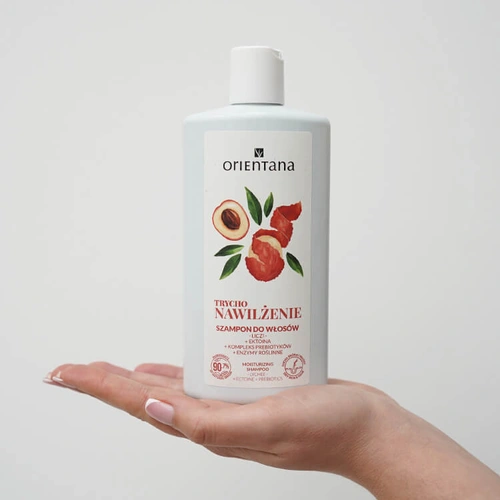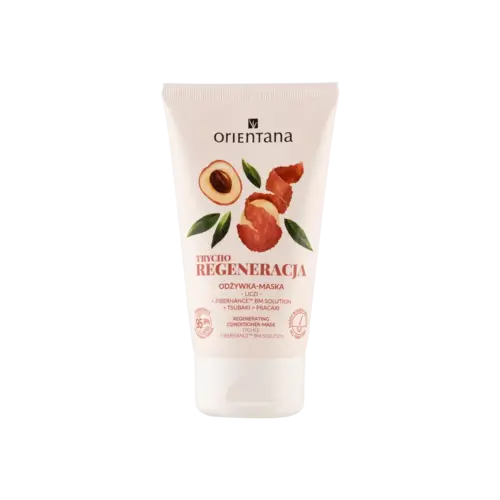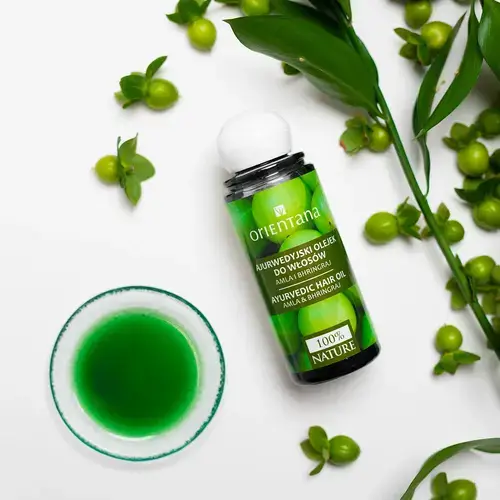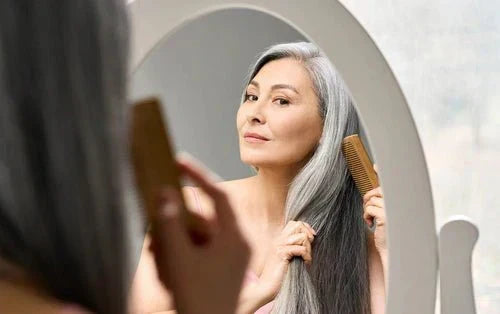Hair graying is a physiological process that occurs with age and is associated with the progressive loss of melanocytes in the hair follicle. These cells are responsible for the production of melanin - a pigment that gives hair its natural color. Reduced melanocyte activity and finally their complete degeneration causes gray hair to appear - devoid of pigment. This process can begin after the age of 30 and is determined both genetically and environmentally.
Studies indicate that gray hair differs not only in color, but also in structure and physicochemical properties. Hair without melanin has higher porosity, is rougher to the touch, is more brittle and tends to dry out. In addition, melanin also has a protective function against UV radiation - its lack increases the sensitivity of hair to external factors, including solar radiation, air pollution and aggressive chemical ingredients contained in care products and hair dyes.
From a scientific point of view, gray hair care should be subject to care that limits lipid oxidation, protects against oxidative stress and is intensively moisturized. Studies published in the Journal of Cosmetic Dermatology (2020) have shown that the use of antioxidants such as vitamin E (tocopherol), green tea extract (Camellia sinensis) or coenzyme Q10 can improve the structural integrity of gray hair and reduce its brittleness. It is also worth paying attention to film-forming ingredients, such as plant proteins, which create a protective layer on the hair surface, preventing moisture loss.
Another important aspect of grey hair care is eliminating unwanted yellow reflections, which often appear as a result of keratin oxidation or the deposition of metal impurities from water. Products containing purple or blue correcting pigments (e.g. dark purple CI 60730 or blue CI 42090) can effectively neutralize yellowish tones and restore a cool, silver tone to grey hair.
Thermal protection also plays a key role – grey hair is more susceptible to damage caused by heat styling. Ingredients such as hydrolysed keratin, panthenol or oils rich in unsaturated fatty acids (e.g. grape seed oil, tsubaki oil) have a protective effect against high temperatures and support the reconstruction of weakened hair structure.
In light of available scientific data, gray hair should be cared for in a multi-stage and holistic manner – care should include cleansing, color protection, moisturizing, and rebuilding the keratin structure. Regular use of cosmetics containing active substances with proven effects can significantly improve the appearance, elasticity, and resistance of gray hair to external factors.
gray hair - Moisturizing and nourishing
Gray hair, due to the lack of melanin, has different physical and chemical properties than pigmented hair. Melanin not only gives hair color, but also affects its structure and moisture level. With its loss, the hair's hydrolipid balance is disturbed, which results in increased dryness, brittleness and loss of elasticity. The structure of the gray hair cortex becomes more porous, which facilitates water loss and makes it more difficult for the hair to retain moisture within its structure.
According to research published in the International Journal of Trichology (2018), gray hair is characterized by a lower content of internal lipids and a higher degree of keratin oxidation. These changes translate into reduced hair elasticity and greater susceptibility to mechanical and thermal damage. Therefore, a key element of gray hair care is to provide it with moisturizing and nourishing substances that will compensate for the loss of the natural protective barrier.

In daily care, it is worth reaching for conditioners and masks containing humectants - water-binding substances such as glycerin, hyaluronic acid, betaine or aloe (Aloe barbadensis). They work by attracting moisture from the environment and retaining it inside the hair.
Humectants should be used in combination with emollients – occlusive ingredients that create a layer on the hair surface that prevents water from evaporating. Effective emollients include vegetable oils (e.g. avocado oil, olive oil, jojoba oil), shea butter, fatty alcohols (cetyl alcohol, cetearyl alcohol).

Hydrolyzed proteins – such as oats or wheat – also play an important role in hair nutrition. They have a regenerative effect on damaged parts of the hair shaft, strengthen its structure and improve its elasticity. A study conducted by a group of researchers from the University of São Paulo (2021) showed that regular use of protein masks increases hair resistance to breakage by up to 40%, which is particularly important in the case of weakened and gray hair.
It is also worth paying attention to the pH of the products you use. Gray hair, like the scalp, responds best to products with a slightly acidic pH (pH 4.5–5.5), which closes the hair cuticles, smoothes its surface and prevents further moisture loss. Products with an alkaline pH can lead to increased porosity and aggravate the problem of dryness.
Gray hair that is systematically cared for with appropriately selected cosmetic formulas and protected from the effects of external factors is the key to maintaining the healthy appearance, softness and elasticity of hair without pigment.
UV protection
Gray hair, due to the loss of melanin, loses its natural protective barrier against the harmful effects of ultraviolet (UV) radiation. Melanin plays an important photoprotective role, absorbing and scattering solar radiation, thus protecting both the hair shaft and hair follicle cells from oxidative damage. In the case of hair without pigment, this protection is significantly weakened, which leads to accelerated aging of the hair fiber.
UV radiation – particularly UVA and UVB radiation – causes photodegradation of keratin proteins, lipid oxidation, and damage to the cortical structure of the hair. Studies by Robbins and Kelly ( Journal of the Society of Cosmetic Chemists , 1991) have shown that exposure of hair to UV radiation leads to a significant loss of its mechanical integrity, and gray hair loses elasticity and becomes more brittle than naturally dark hair. Moreover, prolonged sun exposure results in a change in hair color to a yellowish or yellow-brown shade, which deteriorates its aesthetic appearance.
Gray hair can be protected from UV radiation with cosmetics enriched with antioxidants, which neutralize free radicals generated by solar radiation. Effective antioxidants include tocopherol (vitamin E), ascorbic acid (vitamin C), green tea polyphenols and extracts from adaptogenic plants such as Rhodiola rosea or Withania somnifera. Their presence enhances the photoprotective effect and supports the regeneration of damaged hair structure.
In conditions of intense sunlight – especially in summer and during exposure to the sun in high mountains or by the sea – it is recommended that gray hair be physically protected, in the form of headgear. Wearing hats, caps or scarves protects not only the hair shaft itself, but also the scalp, which in the case of people with thinning hair is also exposed to photodamage.
Avoiding high temperatures
Gray hair, devoid of melanin, is particularly susceptible to damage caused by high temperatures. Melanin not only gives hair its color, but also affects its physicochemical properties, including resistance to thermal stress.
Grey hair, due to its structure, has a thinner lipid layer, is more porous and less elastic, which makes it more susceptible to drying, breaking and split ends.
Research published in the Journal of Cosmetic Science (2004) showed that exposure of hair to temperatures exceeding 150°C leads to degradation of keratin proteins, particularly in the cortex, as well as to irreversible changes in the structure of intercellular lipids.
Gray hair, being more brittle and dry, undergoes these processes more quickly and intensively. Frequent use of straighteners, curling irons or hot air from a hair dryer can lead to a significant deterioration of the hair's condition - a decrease in its mechanical strength, dullness and loss of natural smoothness.
To minimize the effects of heat, it is recommended to limit the use of styling tools based on high temperatures. Whenever possible, it is worth choosing cold styling methods or using devices with temperature control, setting them at a level not exceeding 130-150 ° C. Laboratory studies show that temperatures above 180 ° C cause keratin denaturation and damage to the hair surface after just one use of a straightener.
Gray hair should be protected from heat by using heat protectants. They contain ingredients that create a thin, protective coating on the hair surface that limits heat conduction and reduces water evaporation from the hair.
The most commonly used thermoprotective substances include silicones (e.g. dimethicone, amodimethicone), polymers (e.g. polyquaternium-55, hydroxypropyltrimonium hydrolyzed wheat protein). We recommend natural ingredients such as natural oils rich in unsaturated fatty acids, such as rice oil, coconut oil or grape seed oil.
In a study by Jung et al. (2011), it was shown that using a product containing dimethicone before using a straightener significantly reduced moisture loss and limited damage to the cuticular layer. The protection was even more effective when the product also contained plant proteins, which penetrate the hair and support its reconstruction.
It is also worth remembering that hair is most susceptible to overheating when it is still damp. Wet styling – especially straightening or curling – leads to rapid evaporation of water, which can cause the so-called "bubble hair" effect, i.e. the formation of microscopic air bubbles in the hair structure, leading to its breakage. For this reason, you should always dry your hair thoroughly before using heating devices, using a cooler airflow and thermal protection.
gray hair - Diet and supplementation
The condition of hair, including its pigmentation, elasticity and resistance to damage, is closely linked to general health and diet. Graying of hair, although primarily genetically determined and related to the aging process, can be accelerated by deficiencies of certain vitamins and microelements. The scientific literature increasingly emphasizes the role of nutrients in maintaining the health of hair follicles and potentially delaying depigmentation processes.
B vitamins, especially vitamin B12 (cobalamin), play a key role in the metabolism of hair follicle cells. B12 deficiency can lead to megaloblastic anemia, a symptom of which is premature graying. A study published in the International Journal of Trichology (2013) found significantly lower levels of vitamin B12 and folate (B9) in young people with premature graying compared to the control group. Other B vitamins, such as B6 (pyridoxine) and B7 (biotin), support keratin synthesis and scalp health.
Minerals also play an important role in maintaining hair pigmentation. Copper is an essential cofactor for tyrosinase, an enzyme responsible for melanin synthesis. Its deficiency can disrupt this process and lead to hair loss. Zinc, on the other hand, is involved in cell division and supports hair growth. A review of the literature published in Dermatology and Therapy (2020) indicated that both zinc and copper deficiency can affect hair quality and pigmentation, although further clinical studies are needed to determine the exact mechanisms behind these relationships.
In addition to vitamins and minerals, bioactive compounds with antioxidant effects, such as polyphenols, flavonoids and plant adaptogens, are gaining increasing interest. Antioxidants neutralize free radicals that can contribute to oxidative stress in the hair follicle – considered one of the factors leading to graying. Extracts from green tea, ginseng (Panax ginseng), turmeric (Curcuma longa) and ashwagandha (Withania somnifera) have been shown to have a beneficial effect on scalp health and the hair growth cycle, and some of them can also support pigment retention.
It is worth remembering that supplementation should always be tailored individually, preferably after consulting a doctor or dietitian and after performing laboratory tests. An excess of some ingredients (e.g. zinc or selenium) can be harmful, so supplements should not be used without control. The most effective and safest is to include natural sources of nutrients in the diet: fish, eggs, nuts, seeds, leafy vegetables, whole grains and legumes.
gray hair and stress
Stress, especially chronic stress, plays a significant role in accelerating the aging process, including hair graying. One of the key biological mechanisms through which stress affects hair follicles is oxidative stress – a state of imbalance between the production of free radicals and the body's ability to neutralize them with antioxidants. Free radicals can damage melanocyte cells responsible for melanin production, which leads to premature hair depigmentation.
Research conducted by scientists from Harvard University (Zhang et al., Nature , 2020) has shown a direct link between stress and melanocyte loss. In a mouse model, severe stress was shown to activate the sympathetic nervous system, which leads to the release of norepinephrine within the hair follicle. This substance induces excessive activity of melanocyte stem cells, which then become exhausted, resulting in permanent pigment loss. Although this mechanism has been thoroughly studied in animals, it suggests that stress in humans may also accelerate the graying process through similar biological pathways.
Reducing psychological and physiological stress can therefore be an important element in the care of gray hair, not only from an aesthetic but also a biological perspective. Proven methods of reducing stress include breathing techniques, mindfulness meditation, yoga, and regular physical activity. A study published in JAMA Internal Medicine (2014) showed that daily practice of mindfulness meditation lowers cortisol levels – the stress hormone – and improves emotional balance and sleep quality, which can have a positive effect on the condition of the skin and hair.
Physical activity also plays a significant role in neutralizing the effects of stress. Regular aerobic exercise, such as brisk walking, swimming, or cycling, increases endorphin production and supports the body's detoxification processes, reducing systemic inflammation and oxidative stress. Long-term benefits of physical activity include improved microcirculation in the scalp, which can support hair follicle nourishment and proper functioning.
It is also worth emphasizing the role of adaptogens – plant substances that support the body's resistance to stress. Extracts from plants such as Rhodiola rosea, Withania somnifera (ashwagandha) or Eleutherococcus senticosus can affect the HPA axis (hypothalamus-pituitary-adrenal glands), regulating cortisol levels and strengthening resistance to mental stress. Some of these substances also have antioxidant effects, which makes them an interesting addition to graying prevention.
How to protect your hair from premature graying

To delay the process of premature graying of hair, it is worth implementing appropriate care. Ayurvedic Amla and Bhringraj hair oil will work great here. This is a product based on traditional recipes of Ayurvedic medicine. It contains extracts of amla fruit (Emblica officinalis) and bhringraj herbs (Eclipta alba), which are valued for their properties of strengthening hair, stimulating its growth and preventing premature graying. Regular use of this oil nourishes the scalp, strengthens hair follicles and can delay the process of pigmentation loss.
Amla (Emblica officinalis) – also known as Indian gooseberry – protects hair from premature graying, as confirmed by both traditional Ayurvedic medicine and a growing body of scientific research. Some studies on animal and cell models have shown that compounds contained in amla can stimulate the activity of tyrosinase – an enzyme crucial for melanin synthesis.
This suggests the potential of amla to slow down pigment loss. Amla is exceptionally rich in vitamin C and polyphenols (e.g. emblicanins A and B), which have strong antioxidant effects. They help neutralize free radicals that damage melanocytes – cells responsible for producing melanin (hair pigment).
How to use Ayurvedic Amla Bhringraj Oil? Massage a small amount of the oil into the scalp and spread over the entire length of the hair. Leave it for a few hours or overnight, then wash your hair with a gentle shampoo. Regular use, e.g. 2-3 times a week, can bring the best results in the form of strengthened, healthy hair with preserved natural pigmentation.
We now know that gray hair requires a holistic approach that considers both external care methods and internal health factors. Evidence-based strategies can help maintain the health and aesthetics of gray hair.






